View in other NatureServe Network Field Guides
NatureServe
Montana
Utah
Wyoming
Idaho
Wisconsin
British Columbia
South Carolina
Yukon
California
New York
A Boat Moss - Hygrohypnum bestii
Other Names:
A Hygrohypnum Moss
General Description
Plants: Pleurocarpous (Vitt 1988), robust, growing in interwoven mats or open clumps (Lawton 1971), abrasive or seldom soft, olivaceous, frequently yellow, sometimes green with yellow tones and dappled with gold (FNA 2014), turning brownish in time (Lawton 1971). Stems sometimes reaching 12 cm, freely branching, frequently with leaves stripped at the stem base or only leaf base fragments remaining, possessing a faint central strand or not; paraphyllia lacking (FNA 2014).
Leaves: Frequently spreading widely to 90 degrees above, straight, or sometimes curved (FNA 2014), and often a little bent or twisted when dry (Lawton 1971), lightly resting next to the stem and overlapping when moist, 1-3 mm in length, 1-2 mm in width (FNA 2014), typically longer than wide (Lawton 1971), cupped, not pleated, egg-shaped to widely so (FNA 2014), narrowing from below mid-leaf (Lawton 1971) to an obtuse or slightly narrower-angled apex; the base extending down the stem; leaf edges smooth, seldom finely-toothed apically; costa typically paired with one or both arms extending halfway up the leaf, sometimes solitary, extending past the middle and forking above (FNA 2014). Some branch leaves not as large as stem leaves (Lawton 1971).
Leaf Cells: Apical cells typically diamond-shaped to quadrate and somewhat rounded; medial cells very slender and bending or wavy to somewhat diamond-shaped and wavy, mostly longer and narrower than the lower laminal cells; lower laminal cells eventually yellowing or becoming somewhat brown; cells along margin quite long, not forming a border; alar cells short and oblong to square, the alar area not distinct from adjacent regions or the border ill-defined (FNA 2014).
Diagnostic Characteristics
The very long marginal cells (typically over 60 micrometers and sometimes exceeding 90 micrometers) of Hygrohypnum bestii separate it from H. duriusculum and H. molle. The marginal cells of the latter two species seldom exceed 55 micrometers or seldom reach 60 micrometers respectively (FNA 2014).
Range Comments
North American Range
Canada: BC and AB, ON to NB and NL; USA: AK, OR and CA, ID and UT, MT to NM, also SD and MI (FNA 2014). Known in Montana from Carbon, Flathead, Glacier, Lake, Lewis and Clark, Lincoln, Meagher, Park, and Ravalli Counties (Elliott and Pipp 2016).
Observations in Montana Natural Heritage Program Database
Number of Observations: 40
(Click on the following maps and charts to see full sized version)
Map Help and Descriptions
Relative Density
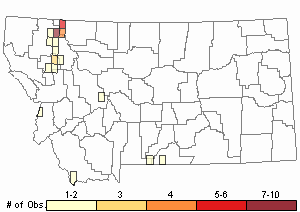
Recency
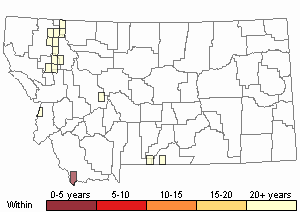
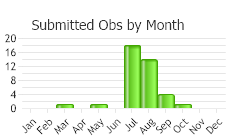
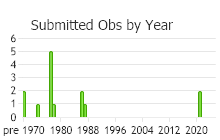
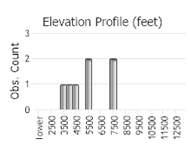 (Observations spanning multiple months or years are excluded from time charts)
(Observations spanning multiple months or years are excluded from time charts)
Habitat
Close to water (Lawton 1971) or on wet rock in montane streams (Elliott and Pipp 2016). Growing at montane elevations to 9840 feet (FNA 2014).
Reproductive Characteristics
Dioicous with female and male plants similar. Exterior perichaetial leaves 1-1.7 mm in length during fruiting, typically spreading 90 degrees, the inner bracts sometimes reaching 3.5 mm when mature (Lawton 1971). Seta 12 to 25 mm tall, red or deep purplish-red (FNA 2014). Capsule somewhat bowed, the theca sometimes reaching 2.5 mm in length, contracted below the opening when dry; stomata present in the short neck; exostome teeth 16, finely and transversely striate; endostome processes 16, papillose, their keels perforate; cilia to half the height of the endostome segments or scarcely developed (Lawton 1971).
Stewardship Responsibility
References
- Literature Cited AboveLegend:
 View Online Publication
View Online Publication Elliott, J.C. and A.K. Pipp. 2018. A Checklist of Montana Mosses (1880-2018). Updated 3 January, 2020. Montana Natural Heritage Program, Helena, Montana. 73 pp.
Elliott, J.C. and A.K. Pipp. 2018. A Checklist of Montana Mosses (1880-2018). Updated 3 January, 2020. Montana Natural Heritage Program, Helena, Montana. 73 pp. Flora of North America Editorial Committee, eds. 2014. Flora of North America North of Mexico. Volume 28. Bryophytes: Mosses, Part 2. Oxford University Press, Inc., NY. xxi + 702 pp.
Flora of North America Editorial Committee, eds. 2014. Flora of North America North of Mexico. Volume 28. Bryophytes: Mosses, Part 2. Oxford University Press, Inc., NY. xxi + 702 pp. Lawton, E. 1971. Moss Flora of the Pacific Northwest. Hattori Botanical Laboratory. Japan: Yamabuki-cho, Shinjuku-ku, Tokyo. 362 pages plus appendices.
Lawton, E. 1971. Moss Flora of the Pacific Northwest. Hattori Botanical Laboratory. Japan: Yamabuki-cho, Shinjuku-ku, Tokyo. 362 pages plus appendices. Vitt, D. J. Marsh, and R. Bovey. 1988. Mosses, Lichens & Ferns of Northwest North America. Seattle, WA: University of Washington Press. 296 p.
Vitt, D. J. Marsh, and R. Bovey. 1988. Mosses, Lichens & Ferns of Northwest North America. Seattle, WA: University of Washington Press. 296 p.
- Additional ReferencesLegend:
 View Online Publication
View Online Publication
Do you know of a citation we're missing? Crum, H.A. and L.E. Anderson. 1981. Mosses of Eastern North America. 2 volumes. Columbia University Press, New York. 1328 pp.
Crum, H.A. and L.E. Anderson. 1981. Mosses of Eastern North America. 2 volumes. Columbia University Press, New York. 1328 pp. Elliot, J. C. 1993. Second checklist of Montana mosses. Unpublished report. U.S. Forest Service, Region 1. Missoula, MT. 45 pp.
Elliot, J. C. 1993. Second checklist of Montana mosses. Unpublished report. U.S. Forest Service, Region 1. Missoula, MT. 45 pp. Flowers, S. 1973. Mosses: Utah and the West. Brigham Young University, Provo, Utah. 567 p.
Flowers, S. 1973. Mosses: Utah and the West. Brigham Young University, Provo, Utah. 567 p. Lawton, E. 1971. Keys for the Identification of the Mosses on the Pacific Northwest. Reprinted from 'Moss Flora of the Pacific Northwest'. Published as Supplement No. 2 of the Journal of the Hattori Botanical Laboratory. Nichinan, Miyazaki, Japan. 66 pp.
Lawton, E. 1971. Keys for the Identification of the Mosses on the Pacific Northwest. Reprinted from 'Moss Flora of the Pacific Northwest'. Published as Supplement No. 2 of the Journal of the Hattori Botanical Laboratory. Nichinan, Miyazaki, Japan. 66 pp. Malcolm, B., N. Malcolm, J. Shevock, and D. Norris. 2009. California Mosses. Nelson, New Zealand: Micro-Optics Press. 430 pp.
Malcolm, B., N. Malcolm, J. Shevock, and D. Norris. 2009. California Mosses. Nelson, New Zealand: Micro-Optics Press. 430 pp.
- Web Search Engines for Articles on "A Boat Moss"





